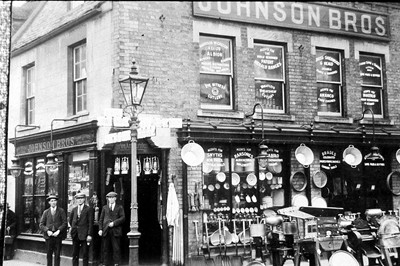
The loss of our small shops
by REX NEEDLE
|
The rise in popularity of the supermarket over the past forty years has meant the closure of many of our small shops, particularly those dealing in specialist goods, and those that survive struggle against rising costs and competition from the Internet. One stop shopping has become so popular among housewives that the face of our town centres has changed dramatically with services such as banks, insurance companies, estate agents and charity shops taking over the premises previously occupied by traditional retail outlets such as the butcher, the baker and the candlestick maker. The nature of a community can be identified through the occupations pursued by those who work in it but these change with the times. A good example is the transition of blacksmith to motor mechanic because the forge often became the garage as horse transport was replaced by the motor car during the early years of the 20th century. Bourne has had a busy commercial life since mediaeval times but the trades in which its people were involved in centuries past bear little recognition to those we find today and even with those that are similar, their businesses are conducted in a very different fashion. An indication of the trades pursued in early 19th century appears in trade directions from the period. Slater's Directory for Lincolnshire 1857, for instance, tells us that in Bourne and Eastgate together there were 15 boot and shoe makers, 12 bakers and flour dealers, five blacksmiths, seven carpenters and joiners, two wheelwrights and 17 grocers, some of whom were also drapers. A further ten people are listed as tailors and drapers along with ten milliners and dressmakers, five saddlers and harness makers, five hatters, six bricklayers and builders with a further five men described as stone masons, five maltsters and brewers, six butchers, three millers, three ironmongers and two agricultural implement makers. In addition, there was an entire gallery of other occupations and crafts that have now largely died out. These included two brick and tile makers, two coopers, two leather cutters, two lime-burners (both at Dyke), two rope and sacking makers, two slaters, two stay-makers, and five straw bonnet makers. Among others listed were a brazier and tinman, a basket maker, a bird and animal preserver, a tobacco pipe maker, a leather breeches maker and a glover, all of this at a time when the population of Bourne was under 4,000. The idea of one-stop shopping was totally unknown and a weekly trek to town to buy clothes, groceries and other necessities a regular occurrence for housewives, moving from shop to shop until all of their purchases had been made, often waiting in queues during busy periods before facing the long walk home carrying a heavy basket. Household necessities were supplied by Johnson Brothers at the corner of South Street and West Street, an Aladdin’s cave of necessary items for the house and garden, the frontage always adorned with examples of their wares in an attempt to entice buyers from a shop that sold ironmongery and hardware under various owners for 160 years (pictured above). There was an equally fascinating establishment in North Street which was used as a chemist's shop from the early years of the 19th century, the business originally run by John Bellairs Roberts but taken over by Edgar Judge in 1890. It subsequently became known locally as Judge's with an attractive Victorian frontage and an equally ancient interior, the walls lined with an assortment of pharmaceutical bottles and phials which remained unchanged until the building was pulled down in 1988, despite being Grade II listed. But the most memorable of these traditional shops was John Smith of Bourne, grocers to the gentry from 1857 until recent times. For almost 150 years, the business was run by the Smith family in the Victorian fashion, supplying products at the quality end of the market, and the store exuded a gentlemanly air of courtesy and service well into the age when the self-service supermarket was beginning to reign supreme. Cold lunches were served to regular customers on market day when the shop became a meeting place, hung with hams and replete with butter and cheese made locally. Customers were greeted by the aroma of freshly-ground coffee and the scent of spices, unhurried personal service, scrubbed floorboards and a polished mahogany counter worn smooth over the years by thousands of daily transactions, a delightful change to the hurly burly of the checkout tills we know today while the window displays and metal advertising signs reminded us of a bygone age when our daily life proceeded at a more leisurely pace. When the shop eventually closed in December 1998, the town lost a small part of its traditional role for customer service and its death knell coincided with the burgeoning success of the supermarkets. In the autumn of 2001, planning permission was granted to convert the premises into a public house which opened in May 2002 and the new owners incorporated several of the original features in the refurbished premises which became known as Smith's of Bourne, still a popular call but with a very different clientele. The wide variety of retail outlets continued until well into the 20th century when shopping habits began to change with the opening of Budgens, our first supermarket, in 1976, originally occupying cramped premises in West Street but soon to move to a larger and more modern building in the Burghley Centre, becoming the most important retail outlet in the town when it opened in 1989 with more than 160 adjoining car parking spaces. Since then we have had Rainbow, now Co-operative Food, Sainsbury's, Tesco and Lidl on the way, with several other outlets operating as mini supermarkets while many of the traditional shops are all but a memory and with them has gone the personal service of yesteryear. |